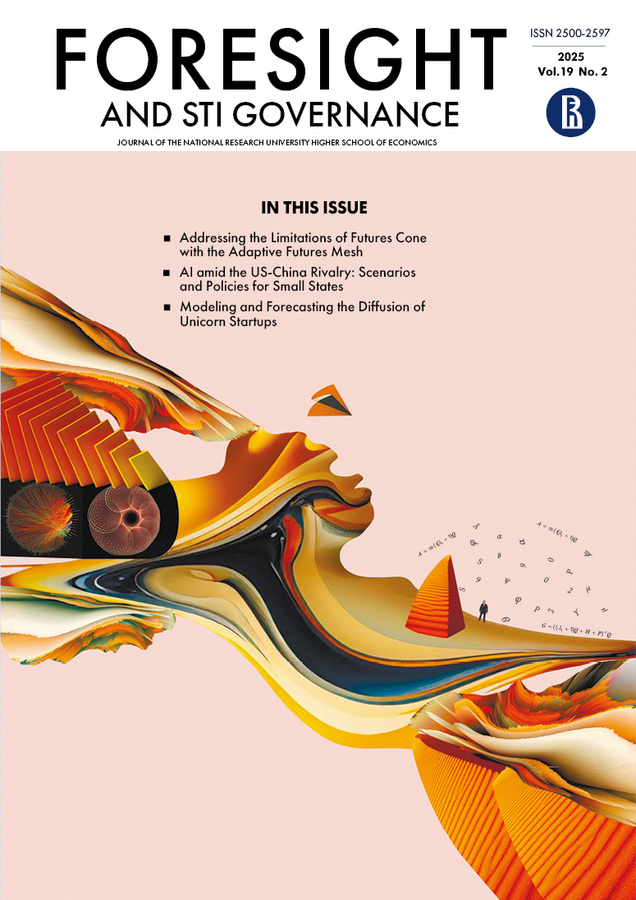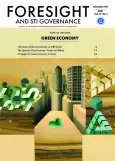Foresight for Small and Medium Enterprises in the Context of the Circular Economy
- Authors: Anzules-Falcones W.1, Diaz-Marquez A.M1, Padilla L.1, Hernan-Hidalgo D.1, Sanchez-Grisales D.1
-
Affiliations:
- Universidad de Las Americas, De Los Colimes esq, Quito 170513, Ecuador
- Issue: Vol 15, No 1 (2021)
- Pages: 86-96
- Section: GREEN ECONOMY
- URL: https://journals.rcsi.science/1995-459X/article/view/303347
- DOI: https://doi.org/10.17323/2500-2597.2021.1.86.96
- ID: 303347
Cite item
Abstract
Small, medium, and micro enterprises make important contributions to economic growth and employment. Based on evidence from of the tire processing industry in Ecuador, this article assesses the development prospects for such companies in the context of the transition to a circular economy. The methodological basis of the study is scenario planning. Five scenario hypotheses are proposed and the probability of their implementation is estimated. The most optimal scenario (in which all five hypotheses are realized) is feasible and subject to a set of measures, including the development of new management and marketing tools, the involvement of universities and research centers in the creation of new low-cost waste processing technologies, and the organization of a special fund to support research and development in companies focused on the circular model.
Keywords
About the authors
W. Anzules-Falcones
Universidad de Las Americas, De Los Colimes esq, Quito 170513, Ecuador
Author for correspondence.
Email: wendy.anzules@udla.edu.ec
A. M Diaz-Marquez
Universidad de Las Americas, De Los Colimes esq, Quito 170513, Ecuador
Email: angela.diaz@udla.edu.ec
L. Padilla
Universidad de Las Americas, De Los Colimes esq, Quito 170513, Ecuador
Email: leon.padilla@udla.edu.ec
D. Hernan-Hidalgo
Universidad de Las Americas, De Los Colimes esq, Quito 170513, Ecuador
Email: daniel.hidalgo@udla.edu.ec
D. Sanchez-Grisales
Universidad de Las Americas, De Los Colimes esq, Quito 170513, EcuadorReferences
- Astigarraga E. (2016) Prospectiva estrategica: Origenes, conceptos clave e introduccion a su practica, Revista Centroamericana de Administracion Publica, (71), 13-29. 10.35485/rcap71_1 (in Spanish). DOI: https://doi.org/10.35485/rcap71_1(inSpanish)
- Bennett N., Lemoine J. (2014) What a Difference a Word Makes: Understanding Threats to Performance in a VUCA World. Business Horizons, 57(3), 311-317. DOI: https://doi.org/10.1016/j.bushor.2014.01.001
- Berger G. (1964) Phenomenologie du temps et prospective, Paris: Presses Universitaires de France (in French).
- Block J. (2012) R&I investments in family and founder firms: An agency perspective. Journal of Business Venturing, 27(2), 248-265. DOI: https://doi.org/10.1016/j.jbusvent.2010.09.003
- Breton-Miller I., Miller D., Lester R.H. (2011) Stewardship or Agency? A Social Embeddedness Reconciliation of Conduct and Performance in Public Family Businesses. Organization Science, 22, pp. 704-721. DOI: https://doi.org/10.1287/orsc.1100.0541
- Burneo S.N. (2016) Inclusion financiera de las pymes en el Ecuador Quito, Quito: Simon Bolivar Andean University. https://repositorio.cepal.org/bitstream/handle/11362/40726/1/S1601059_es.pdf, дата обращения 23.02.2021 (in Spanish).
- Cassia L., De Massis A., Pizzurno E. (2012) Strategic innovation and new product development in family firms: An empirically grounded theoretical framework. International Journal of Entrepreneurial Behaviour and Research, 18(2), pp. 198-232. DOI: https://doi.org/10.1108/13552551211204229
- Chirico F., Nordqvist M. (2010) Dynamic capabilities and trans-generational value creation in family firms: The role of organizational culture. International Small Business Journal, 28(5), 487-504. https://doi.org/10.1177%2F0266242610370402.
- Coates J., Durance P., Godet M. (2010) Strategic Foresight Issue: Introduction. Technological Forecasting and Social Change, 77(9), 1423-1425. DOI: https://doi.org/10.1016/j.techfore.2010.08.001
- Cohen S.G., Bailey D.E. (1997) What Makes Teams Work: Group Effectiveness Research from the Shop Floor to the Executive Suite. Journal of Management, 23(3), 239-290. DOI: https://doi.org/10.1016/S0149-2063(97)90034-9
- Dabic M., Maley J., Dana L.-P., Novak I., Pellegrini M.M., Caputo A. (2020) Pathways of SME internationalization: A bibliometric and systematic review. Small Business Economics, 55(3), pp. 705-725. DOI: https://doi.org/10.1007/s11187-019-00181-6
- De Jouvenel B. (1967) The Art of Conjecture, New York: Basic Books.
- Dekker J., Lybaert N., Steijvers T., Depaire B. (2015) The Effect of Family Business Professionalization as a Multidimensional Construct on Firm Performance. Journal of Small Business Management, 53(2), 516-538. DOI: https://doi.org/10.1111/jsbm.12082
- Dieguez-Soto J., Garrido-Moreno A., Manzaneque M. (2018) Unravelling the link between process innovation inputs and outputs: The moderating role of family management. Journal of Family Business Strategy, 9(2), 114-127. DOI: https://doi.org/10.1016/j.jfbs.2017.11.007
- Dobrota D., Dobrota G. (2018) An innovative method in the regeneration of waste rubber and the sustainable development. Journal of Cleaner Production, 172, 3591-3599. DOI: https://doi.org/10.1016/j.jclepro.2017.03.022
- Dobrota D., Dobrota G., Dobrescu T. (2020) Improvement of waste tyre recycling technology based on a new tyre markings. Journal of Cleaner Production, 260, 121141. DOI: https://doi.org/10.1016/j.jclepro.2020.121141
- Doheny M., Nagali V., Weig F. (2012) Agile operations for volatile times. McKinsey Quarterly, May 2012. https://www.mckinsey.com/business-functions/operations/our-insights/agile-operations-for-volatile-times#, дата обращения 23.02.2021.
- Garcia Penalvo F.J. (2010) Gestion del Conocimiento y la Tecnologia, Salamanca: Universidad de Salamanca. https://repositorio.grial.eu/bitstream/grial/236/1/Gestion_del_conocimiento_y_de_la_tecnologia_GRIAL.pdf, дата обращения 23.02.2021 (in Spanish).
- Gavetti G., Menon A. (2016) Evolution Cum Agency: Toward a Model of Strategic Foresight. Strategy Science, 1(3), 207-233. DOI: https://doi.org/10.1287/stsc.2016.0018
- Godet M. (2011) Strategic Foresight for For Corporate and Regional Development, Paris: UNESCO.
- Godet M., Durance P. (2011) Strategic Foresight: Use and Misuse of Scenario Building, Paris: UNESCO. http://www.laprospective.fr/dyn/francais/actualites/SR10vEng.pdf, дата обращения 23.02.2021.
- Gunday G., Ulusoy G., Kilic K., Alpkan L. (2011) Effects of innovation types on firm performance. International Journal of Production Economics, 133(2), 662-676. DOI: https://doi.org/10.1016/j.ijpe.2011.05.014
- Hambrick D.C., Mason P.A. (1984) Upper Echelons: The Organization as a Reflection of Its Top Managers. The Academy of Management Review, 9(2), 193-206. DOI: https://doi.org/10.2307/258434
- Herrmann P., Nadkarni S. (2014) Managing strategic change: The duality of CEO personality. Strategic Management Journal, 35(9), 1318-1342. DOI: https://doi.org/10.1002/smj.2156
- Howorth C., Wright M., Westhead P., Allcock D. (2016) Company metamorphosis: professionalization waves, family firms and management buyouts. Small Business Economics, 47(3), 803-817. DOI: https://doi.org/10.1007/s11187-016-9761-6
- Hutajulu S., Dhewanto W., Prasetio E.A. (2020) Two scenarios for 5G deployment in Indonesia. Technological Forecasting and Social Change, 160, 120221. DOI: https://doi.org/10.1016/j.techfore.2020.120221
- INEC (2019) Directorio De Empresas Ecuador 2018, Quito: Instituto Nacional de Estadistica y Censos (in Spanish).
- INEC (2020) Clasificacion Nacional de Actividades Economicas, Quito: Instituto Nacional de Estadistica y Censos (in Spanish).
- Kaza S., Yo L., Bhada-Tata P., Van Woerden F. (2018) What a Waste 2.0: A Global Snapshot of Solid Waste Management to 2050, Washington, D.C.: World Bank Group. DOI: https://doi.org/10.1596/978-1-4648-1329-0
- Laure C., De Lassus C., Moguel A. (2017) Como lograr un reciclaje confiable, eficiente y sustentable a traves de la economia circular en america latina, Mexico: Fundacion para el Desarrollo Sostenible en America Latina (FUNDES) (in Spanish).
- Medina Vasquez J. (2006) Manual de prospectiva y decision estrategica: Bases teoricas e instrumentos para America Latina y el Caribe, Santiago: Comision Economica para America Latina y el Caribe (CEPAL). https://repositorio.cepal.org/bitstream/handle/11362/5490/1/S0600190_es.pdf, дата обращения 23.02.2021 (in Spanish).
- Migliori S., De Massis A., Maturo F., Paolone F. (2020) How does family management affect innovation investment propensity? The key role of innovation impulses. Journal of Business Research, 113, 243-256.
- Mitma J.I., Pinzas A.C., Contreras C.C. (2009) Prospectiva estrategica al sector textil del distrito de San Juan de Lurigancho. Industrial Data, 12(2), 40-49. 10.15381/idata.v12i2.6118 (in Spanish). DOI: https://doi.org/10.15381/idata.v12i2.6118(inSpanish)
- Mojica F.J. (1999) Determinism and construction of the future, Bogota: Universidad Externado de Colombia.
- OECD (2019) OECD SME and Entrepreneurship Outlook 2019 Policy Highlights. Paris: OECD. DOI: https://doi.org/10.1787/9789264009257-en
- Peter M., Jarratt D. (2015) The practice of foresight in long-term planning. Technological Forecasting and Social Change, 101, 49-61. DOI: https://doi.org/10.1016/j.techfore.2013.12.004
- Quinteros J., Hamann A. (2017) Planteamiento Estrategico Prospectivo. Metodos MACTOR y SMIC (1st ed.), Bogota: ECOE Ediciones (in Spanish).
- Rohrbeck R. (2012) Exploring value creation from corporate-foresight activities. Futures, 44(5), 440-452. DOI: https://doi.org/10.1016/j.futures.2012.03.006
- Schwartz P. (1996) The Art of the Long View: Scenario Planning - Protecting Your Company Against an Uncertain Future, New York: Wiley.
- Stephenson D., Faucher I. (2019) Estudio comparativo de las legislaciones y politicas publicas de Responsabilidad Extendida del Productor para envases y contenedores, Bogota: IRR https://latitudr.org/wp-content/uploads/2018/12/Estudio-REP-IRR-1.pdf (in Spanish).
- Teece D.J., Pisano G., Shuen A. (2009) Dynamic capabilities and strategic management. Knowledge and Strategy, 18, 77-116. DOI: https://doi.org/10.1142/9789812796929_0004
- Un C.A., Asakawa K. (2015) Types of R&D Collaborations and Process Innovation: The Benefit of Collaborating Upstream in the Knowledge Chain. Journal of Product Innovation Management, 32(1),. DOI: https://doi.org/10.1111/jpim.12229
- Vandekerkhof P., Steijvers T., Hendriks W., Voordeckers W. (2015) The Effect of Organizational Characteristics on the Appointment of Nonfamily Managers in Private Family Firms: The Moderating Role of Socioemotional Wealth. Family Business Review, 28(2), 104-122. https://doi.org/10.1177%2F0894486513514274.
- Vandekerkhof P., Steijvers T., Hendriks W., Voordeckers W. (2018) Socio-Emotional Wealth Separation and Decision-Making Quality in Family Firm TMTs: The Moderating Role of Psychological Safety. Journal of Management Studies, 55(4), 648-676. DOI: https://doi.org/10.1111/joms.12277
- Volberda H., Foss N.J., Lyles M.A. (2010) PERSPECTIVE - Absorbing the Concept of Absorptive Capacity: How to Realize Its Potential in the Organization Field. Organization Science, 21(4), 931-951. http://www.jstor.org/stable/40792483.
- Wilden R., Devinney T.M., Dowling G.R. (2016) The Architecture of Dynamic Capability Research Identifying the Building Blocks of a Configurational Approach. Academy of Management Annals, 10(1), 997-1076. DOI: https://doi.org/10.1080/19416520.2016.1161966
- World Bank (2017) Report on the Treatment of MSME Insolvency. Washington, D.C.: World Bank. https://openknowledge.worldbank.org/handle/10986/26709, дата обращения 23.02.2021.
- Zahra S.A., Hayton J.C., Salvato C. (2004) Entrepreneurship in Family vs. Non-Family Firms: A Resource-Based Analysis of the Effect of Organizational Culture. Entrepreneurship Theory and Practice, 28(4), 363-381. https://doi.org/10.1111%2Fj.1540-6520.2004.00051.x.
Supplementary files









